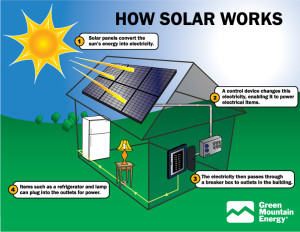At some point in your life, you have probably seen big blue panels on top of houses and thought to yourself, “What are those things?” The objects that you saw are solar panels. They are used as an alternative source of electricity to power homes and businesses. There are many benefits of having solar panels power a home or business. The biggest benefit is the low cost. There is no monthly fee for electricity. The only cost is the purchasing and installation of the panels. After that, no more payment is necessary. Another benefit to solar panels is that it does not create any greenhouse gases, which harm the atmosphere.
A solar panel works by allowing particles of light, or photons, to break electrons free from atoms, which results in a flow of electricity. The particles of light come from the sunlight that is directed at the solar panels. A solar panel is made up of multiple Photovoltaic (PV) Cells, which convert sunlight into electricity.
The PV cells are imbalanced, double silicon layered in order to conduct electricity. Silicon is used because it is a semi-conductor. Therefore, it has similar properties to metal and can insulate electricity. Silicon atoms are put together to create two types of silicon, n-type (negatively charged) and p-type (positively charged). N-type silicon contains spare electrons, and p-type silicon is missing electrons, which create “holes”. When the two types of silicon are combined, an electrical field is created.
When the photons in the sunlight hit the silicon layers in the PV cells, the electrons are knocked off from the atom. The electric field created by the double silicon layers then push the free electrons to the metal conductive plates on the side of the PV cell. Then, the metal plates transfer the electrons to wires, which then transfer the electricity to an inverter. The electricity made by the PV is called direct current electricity (DC). An inverter inverts direct current energy into alternating current electricity (AC), which is needed to power all of the appliances in homes and businesses. Finally, the electricity flows through a breaker box, which then provides electricity to all outlets in the building.
Sources:
http://www.hope-project.org/energy/advantages-and-disadvantages-of-solar-panels/
http://www.solarenergybase.com/how-do-solar-panels-work/



Interesting post. While solar panels do work, as of right now, they are not a viable replacement for the much less green alternatives. Solar panels do produce energy, but only yield about 11-15% of the energy that they consume, making it difficult for them to produce enough energy to sustain our country. Advances have been made, but we are still stuck at this very low efficiency. Hopefully at some point solar energy will be a reasonable option, but not yet.